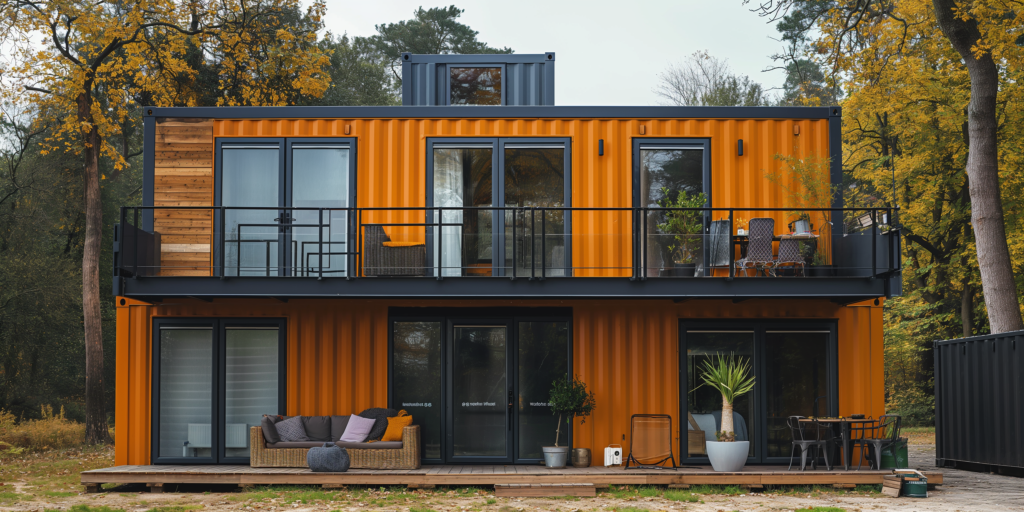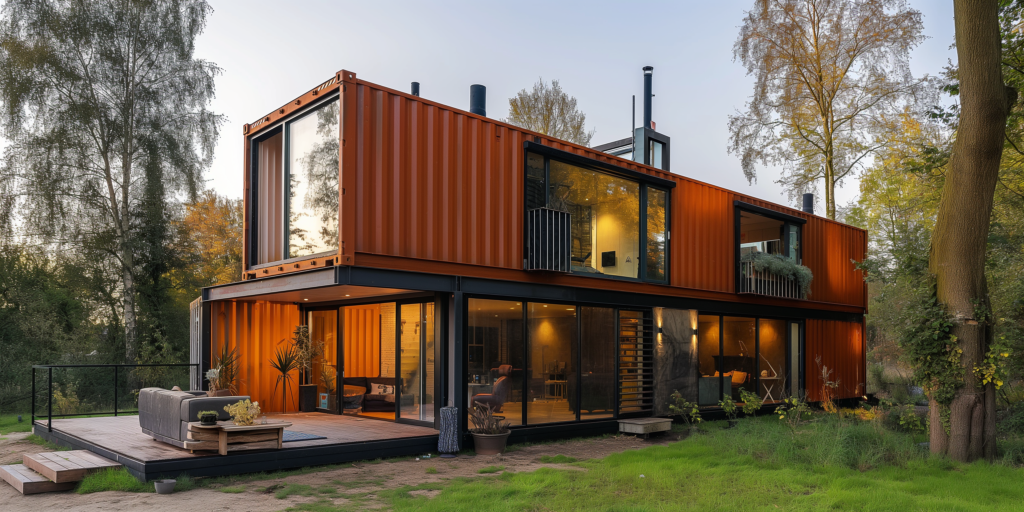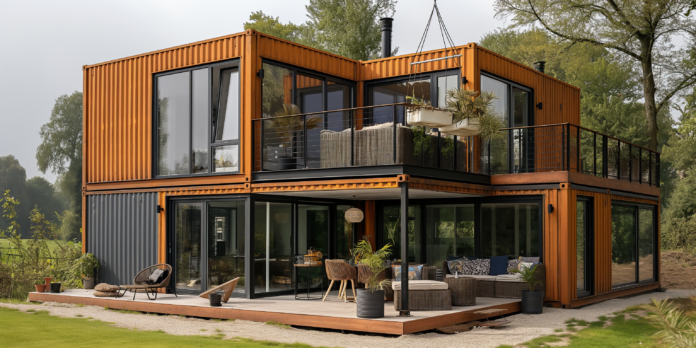In the quest for sustainable, affordable, and stylish living solutions, container homes have emerged as a revolutionary choice. These innovative homes repurpose decommissioned shipping containers into livable spaces, offering a unique blend of modern design and eco-friendliness. Whether you’re a first-time homebuyer, an eco-conscious individual, or simply looking for a cost-effective housing solution, this ultimate guide will walk you through the process of building your own container home step by step.
Step 1: Planning and Design

Before diving into the construction phase, meticulous planning and thoughtful design are crucial.
Setting a Budget: Determine how much you will spend on your container home project. Factor in container costs, site preparation, modifications, utilities, and interior finishes. It’s wise to include a contingency budget for unexpected expenses. Remember, while container homes can be more affordable than traditional homes, unexpected costs can arise, so it’s best to be prepared.
Choosing a Suitable Site: The location of your container home is paramount. Ensure the site is accessible and suitable for construction. Consider factors like soil stability, zoning regulations, and proximity to utilities. Urban areas offer convenience, while rural sites provide more flexibility and lower land costs.
Designing the Layout: Decide on the size and layout of your home. Container homes offer versatile design options, from single-container tiny homes to multi-container structures. Work with an architect experienced in container homes to maximise space and incorporate modern design elements. Think about how you’ll use the space day-to-day to ensure the layout meets your lifestyle needs.
Tips:
- Use 3D modelling software to visualise your design.
- Consider passive solar design principles to enhance energy efficiency.
- Plan for future expansions by designing modular sections.
Step 2: Sourcing Containers
Finding Quality Containers: Purchase containers from reputable suppliers. Look for structurally sound containers free from major rust or damage. Containers come in various grades, from “as-is” to “one-trip” containers, which are used just once before being sold. One-trip containers are usually in the best condition.
Inspecting Containers: Personally inspect each container for structural integrity. Check for rust, dents, and the overall condition. Ensure the containers are free of hazardous materials, especially if they were used to transport chemicals. This step is crucial as any damage or contamination can affect the safety and durability of your home.
Tips:
- Opt for “one-trip” containers, which have only made a single journey and are typically in better condition.
- Ensure your containers are certified for structural use in a building.
Step 3: Preparing the Site

Site Preparation Steps:
- Clearing the Land: Remove any obstacles, such as trees or debris, and level the ground if necessary.
- Laying Foundations: Choose a foundation type that suits your site conditions and design. Options include concrete piers, slab foundations, or steel beams. The foundation must be strong enough to support the weight of the containers and provide stability.
- Ensuring Proper Drainage: Install drainage systems to prevent water accumulation around the foundation. Proper drainage helps protect the foundation and prevent water damage to your home.
Tips:
- Conduct a soil test to determine the best foundation type.
- Check local building codes and obtain necessary permits before starting site preparation.
Step 4: Modifying the Containers
Modification Process:
- Cutting Windows and Doors: Mark and cut openings for windows and doors using a plasma cutter or grinder. Ensure that the cuts are precise to maintain the structural integrity of the containers.
- Reinforcing the Structure: To maintain structural integrity, add steel reinforcements around openings. Welding steel frames around the openings can provide the necessary support.
- Adding Insulation: Insulate the containers to ensure comfort. Options include spray foam, rigid foam panels, or eco-friendly insulation materials. Proper insulation is crucial for temperature control and energy efficiency.
Tips:
- Hire professionals for structural modifications to ensure safety.
- Use high-quality, energy-efficient windows and doors to improve insulation and reduce energy costs.
Step 5: Assembling the Structure

Positioning and Joining Containers:
- Positioning: Use a crane to place the containers on the foundation. Ensure they are level and aligned correctly. This step requires precision to ensure the containers fit together seamlessly.
- Joining: Weld the containers together at key points to create a unified structure. Seal any gaps between containers to prevent water ingress. Proper sealing and welding are crucial for your home’s structural integrity and weatherproofing.
Tips:
- Use professional welders to ensure strong, secure joints.
- Consider adding a weatherproof coating to the exterior for additional protection.
Step 6: Interior and Exterior Finishing
Interior Design Elements:
- Flooring: Install durable flooring materials such as bamboo, laminate, or reclaimed wood. Flooring should be chosen based on durability, aesthetics, and ease of maintenance.
- Walls: Use drywall or plywood for interior walls. Consider adding soundproofing materials for privacy. This is especially important if the home will be located in a noisy area.
- Fixtures: Install modern fixtures and fittings to enhance your home’s aesthetic appeal and functionality. Consider energy-efficient lighting and smart home features.
Exterior Finishes:
- Siding: Add exterior siding to improve insulation and give your home a finished look. Options include wood, metal, or composite materials. Siding not only improves aesthetics but also adds an extra layer of insulation.
- Roofing: Install a sloped roof to facilitate water runoff and provide additional insulation. Consider green roofing options for added sustainability and aesthetic appeal.
Tips:
- Incorporate built-in furniture to maximise space efficiency.
- Use natural materials and light colours to create a warm, inviting interior.
Step 7: Utilities and Sustainability Features

Installing Utilities:
- Plumbing: Connect your home to the local water supply and sewage system. Consider installing a greywater recycling system for sustainability. Ensure all plumbing complies with local building codes.
- Electrical Systems: Hire a licensed electrician to install wiring and connect your home to the grid. Solar panels can provide a renewable energy source. Ensure that your electrical system is sufficient to handle all appliances and future upgrades.
- Heating/Cooling: Install energy-efficient HVAC systems or consider alternative heating methods like underfloor heating. Proper ventilation is also crucial for maintaining indoor air quality.
Sustainability Features:
- Solar Panels: Harness solar energy to reduce reliance on non-renewable power sources. Solar panels can significantly reduce energy costs and environmental impact.
- Rainwater Harvesting: Collect and store rainwater for non-potable uses like irrigation and toilet flushing. This reduces water bills and promotes sustainability.
- Green Roof: Install a green roof to improve insulation and create a natural habitat for local wildlife. Green roofs can also reduce rainwater runoff and improve air quality.
Tips:
- Use LED lighting and energy-efficient appliances to reduce energy consumption.
- Insulate your home well to maintain a comfortable indoor temperature year-round.
Insights and Takeaways
Building a container home in the UK offers a sustainable, affordable, and stylish alternative to traditional housing. By following this step-by-step guide, you can confidently navigate the complexities of container home construction. Each step is crucial in creating a modern, comfortable living space, from planning and design to final finishes.
Embark on your container home journey today and join the growing community of innovative homeowners redefining what it means to live sustainably and stylishly. Share your experiences and questions in the comments below—we’d love to hear from you!


















